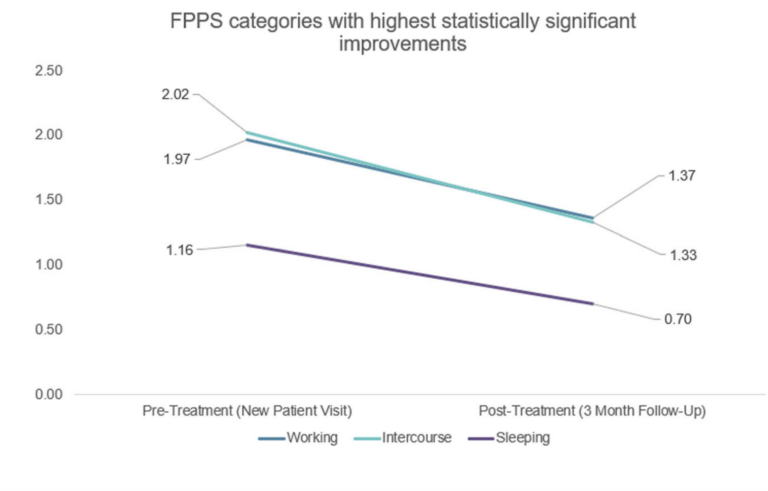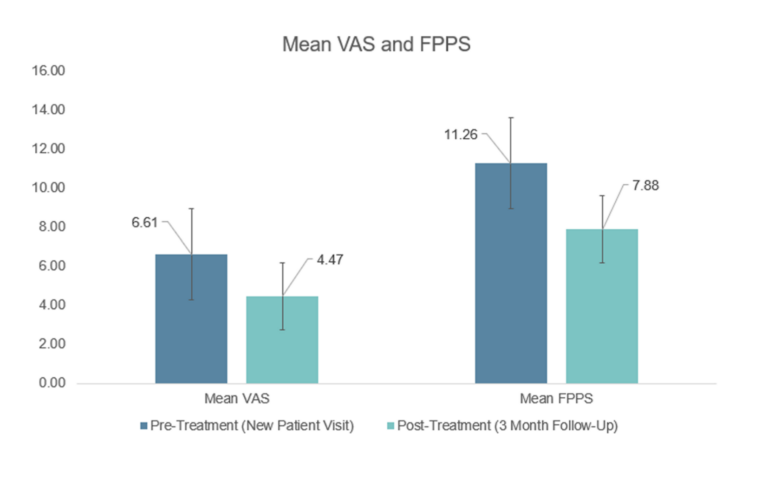The findings of a study of 186 women suffering with chronic pelvic pain supports the success of Pelvic Rehabilitation Medicine’s (PRM) comprehensive treatment protocol for the improvement of pelvic function and reduction of pelvic pain.
What is chronic pelvic pain?
Chronic pelvic pain is a complex, multi-faceted condition involving ongoing pain in the pelvic region which affects both men and women.
Common conditions that cause
chronic pelvic pain in women include:
- Endometriosis
- Irritable bowel syndrome
- Fibroids
- Adenomyosis
- Painful bladder syndrome
Common symptoms that may be
experienced include:
- Abdominal pain
- Frequent urination
- Genital pain
- Lower back pain
- Pain with intercourse
- Pain with sitting

Additionally, previous PRM studies have shown that patients suffering with chronic pelvic pain have an increased risk of both anxiety and depression. This is consistent with 43% of study participants reporting having anxiety and/or depression.

Chronic Pelvic Pain History and Previous Pain Relief Efforts of Study Participants
Patient criteria included a history of chronic pelvic pain lasting longer than six months, including an overwhelming list of previous medications tried to obtain pain relief. Of the participants in this study, 69% reported using a variety of NSAIDS, and 13% reported using opioids in their relief attempts.

PRM’s Multimodal Approach to Treatment in Study
Each patient received six pelvic nerve and muscle treatments (trigger point injections) over the course of six weeks. Patients attended pelvic floor physical therapy with a physical therapist for 1 hour, attending each session within seven days of each injection. Pelvic floor physical therapy in conjunction with injections is referred to as “down training” to restore the peripheral and central nervous systems to a relaxed state and release muscle spasms.
After receiving their treatment, each patient resumed their normal activities and went back to work the same day, after sitting on ice for ten minutes.

During this time, patients were also educated on self-efficacy, lifestyle modifications, and pain management techniques such as stretching, diaphragmatic breathing, taking a warm bath, or using a muscle relaxant for flare-ups.
Results of Ultrasound-Guided Nerve and Muscle Treatments

Each patient’s visual analog scale (VAS) and functional pelvic pain scale (FPPS) were measured prior to treatment and then again three months following their completion of treatment. On average, patients experienced a 32% decrease in their pain and 30% decrease in their inability to have pelvic function.


Of the pelvic functions analyzed prior to the study, patients experienced the highest improvements in function relating to working, intercourse, and sleeping.
A Multimodal Approach Yields Better Outcome for Chronic Pelvic Pain
It is important to note that each patient in this study previously completed recommended pelvic floor physical therapy without seeing improvements in their pain and pelvic functionality. Once it was combined with other modalities creating a comprehensive treatment protocol, these patients experienced alleviations in the pain and function.
With a mission to decrease the time that patients are suffering with pelvic pain, PRM’s treatment protocol addresses the nerve and muscle pain that is experienced by chronic pelvic pain patients. As shown in the results of our study, female patients who were diagnosed with chronic pelvic pain showed a decrease in their VAS and FPPS scores after having experienced an average duration of pain for 6-7 years.

Since the pain our patients were experiencing for so long was chronic and not acute, the treatment they received provided significant relief. Our goal is to help patients reduce their visits to the emergency room and their reliance on medications such as hormones and opioids. This study provides hope for those patients looking for alternative and lasting relief for their pelvic pain. Additional data collected by PRM shows that our protocol has reduced patient use of opioids by 68% and reduced their visits to the emergency room by 97%.
Author contributions:
Allyson Shrikhande, MD
Christian Reutter, DO
Tayyaba Ahmed, DO
Yogita Tailor, DO
Rakhi Vyas, DO
Gabrielle Daniel, MD
Melanie Howell, DO
Soha Patil, BSc
The full study can be viewed here.
Would You Like to See a Specialist?
Call us at (646) 481-4998 or click to request a regular appointment.